Exploring Power, Culture, Politics, and Motivation in Organizations
VerifiedAdded on 2023/06/18
|19
|5855
|485
Report
AI Summary
This report provides an in-depth analysis of organizational behavior, examining the influence of power, culture, and politics on individual and team behavior within organizations, using Tesco as a case study. It explores various theories of motivation, including Maslow's hierarchy of needs, Herzberg's two-factor theory, and Adam's equity theory, evaluating their effectiveness in boosting employee morale and productivity. The report also discusses the characteristics of effective teams and relevant team development theories, highlighting the positive and negative impacts of organizational behavior concepts and philosophies on workplace dynamics. Ultimately, it emphasizes the importance of understanding these factors for fostering a positive and productive work environment.
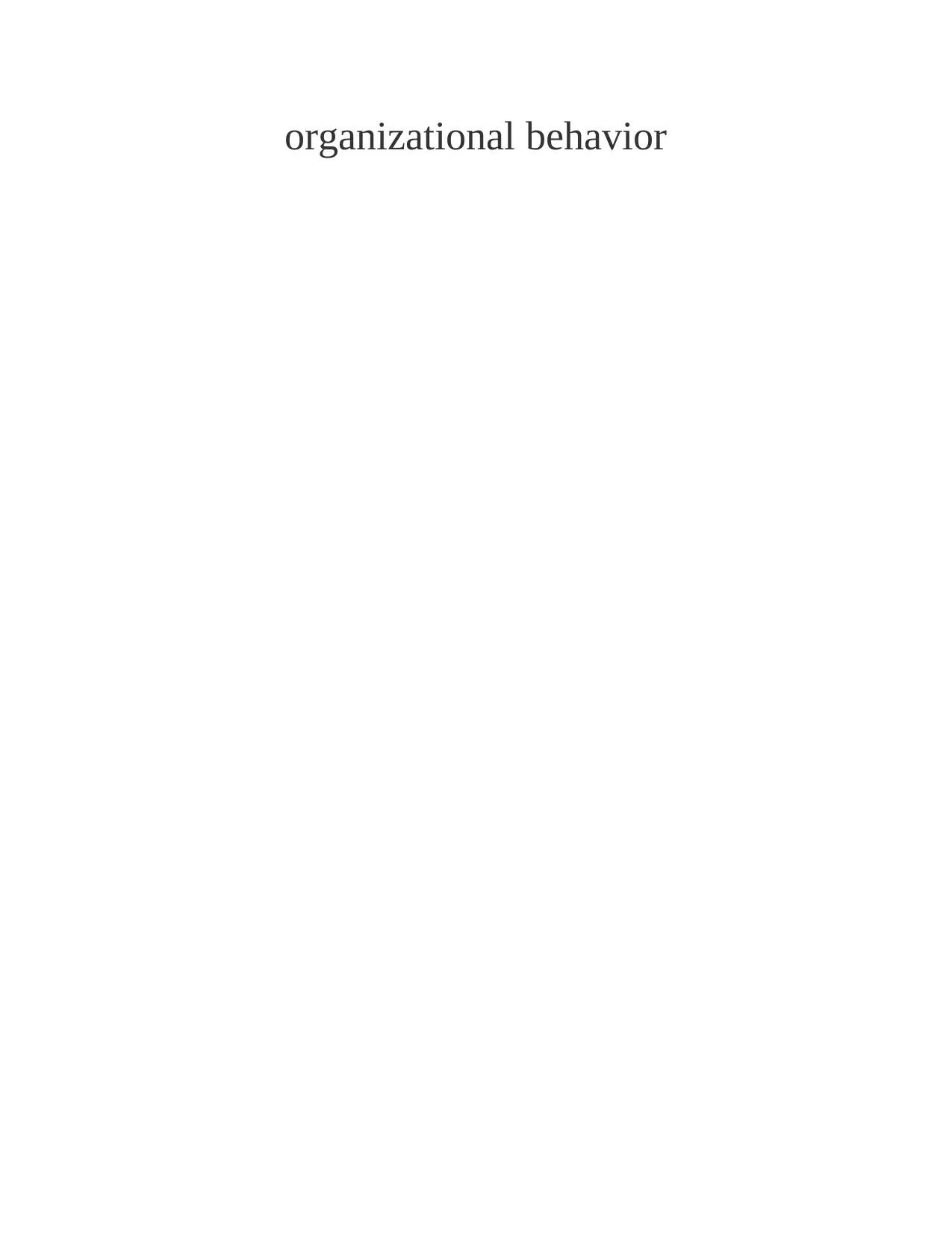
organizational behavior
Paraphrase This Document
Need a fresh take? Get an instant paraphrase of this document with our AI Paraphraser
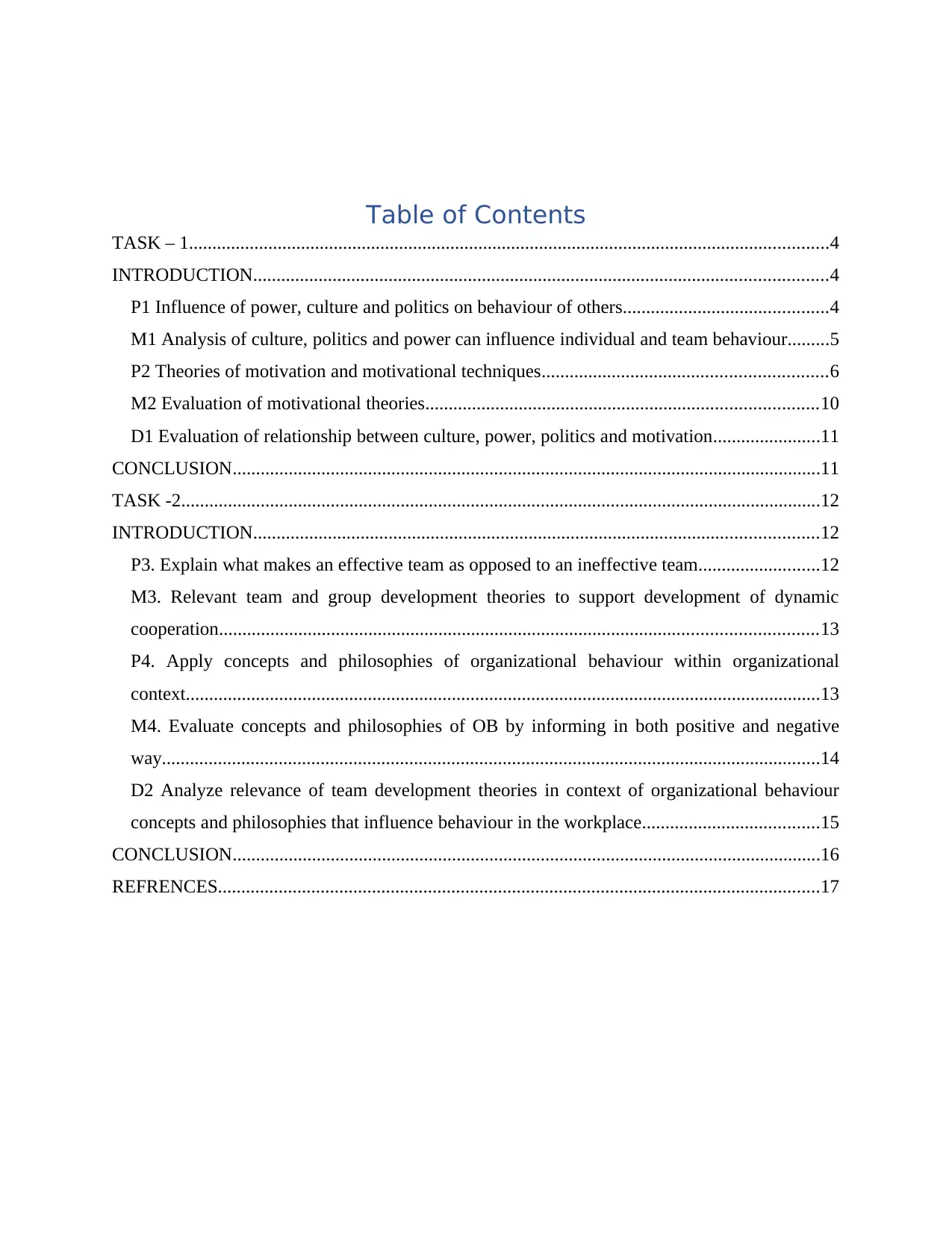
Table of Contents
TASK – 1.........................................................................................................................................4
INTRODUCTION...........................................................................................................................4
P1 Influence of power, culture and politics on behaviour of others............................................4
M1 Analysis of culture, politics and power can influence individual and team behaviour.........5
P2 Theories of motivation and motivational techniques.............................................................6
M2 Evaluation of motivational theories....................................................................................10
D1 Evaluation of relationship between culture, power, politics and motivation.......................11
CONCLUSION..............................................................................................................................11
TASK -2.........................................................................................................................................12
INTRODUCTION.........................................................................................................................12
P3. Explain what makes an effective team as opposed to an ineffective team..........................12
M3. Relevant team and group development theories to support development of dynamic
cooperation................................................................................................................................13
P4. Apply concepts and philosophies of organizational behaviour within organizational
context........................................................................................................................................13
M4. Evaluate concepts and philosophies of OB by informing in both positive and negative
way.............................................................................................................................................14
D2 Analyze relevance of team development theories in context of organizational behaviour
concepts and philosophies that influence behaviour in the workplace......................................15
CONCLUSION..............................................................................................................................16
REFRENCES.................................................................................................................................17
TASK – 1.........................................................................................................................................4
INTRODUCTION...........................................................................................................................4
P1 Influence of power, culture and politics on behaviour of others............................................4
M1 Analysis of culture, politics and power can influence individual and team behaviour.........5
P2 Theories of motivation and motivational techniques.............................................................6
M2 Evaluation of motivational theories....................................................................................10
D1 Evaluation of relationship between culture, power, politics and motivation.......................11
CONCLUSION..............................................................................................................................11
TASK -2.........................................................................................................................................12
INTRODUCTION.........................................................................................................................12
P3. Explain what makes an effective team as opposed to an ineffective team..........................12
M3. Relevant team and group development theories to support development of dynamic
cooperation................................................................................................................................13
P4. Apply concepts and philosophies of organizational behaviour within organizational
context........................................................................................................................................13
M4. Evaluate concepts and philosophies of OB by informing in both positive and negative
way.............................................................................................................................................14
D2 Analyze relevance of team development theories in context of organizational behaviour
concepts and philosophies that influence behaviour in the workplace......................................15
CONCLUSION..............................................................................................................................16
REFRENCES.................................................................................................................................17

⊘ This is a preview!⊘
Do you want full access?
Subscribe today to unlock all pages.

Trusted by 1+ million students worldwide
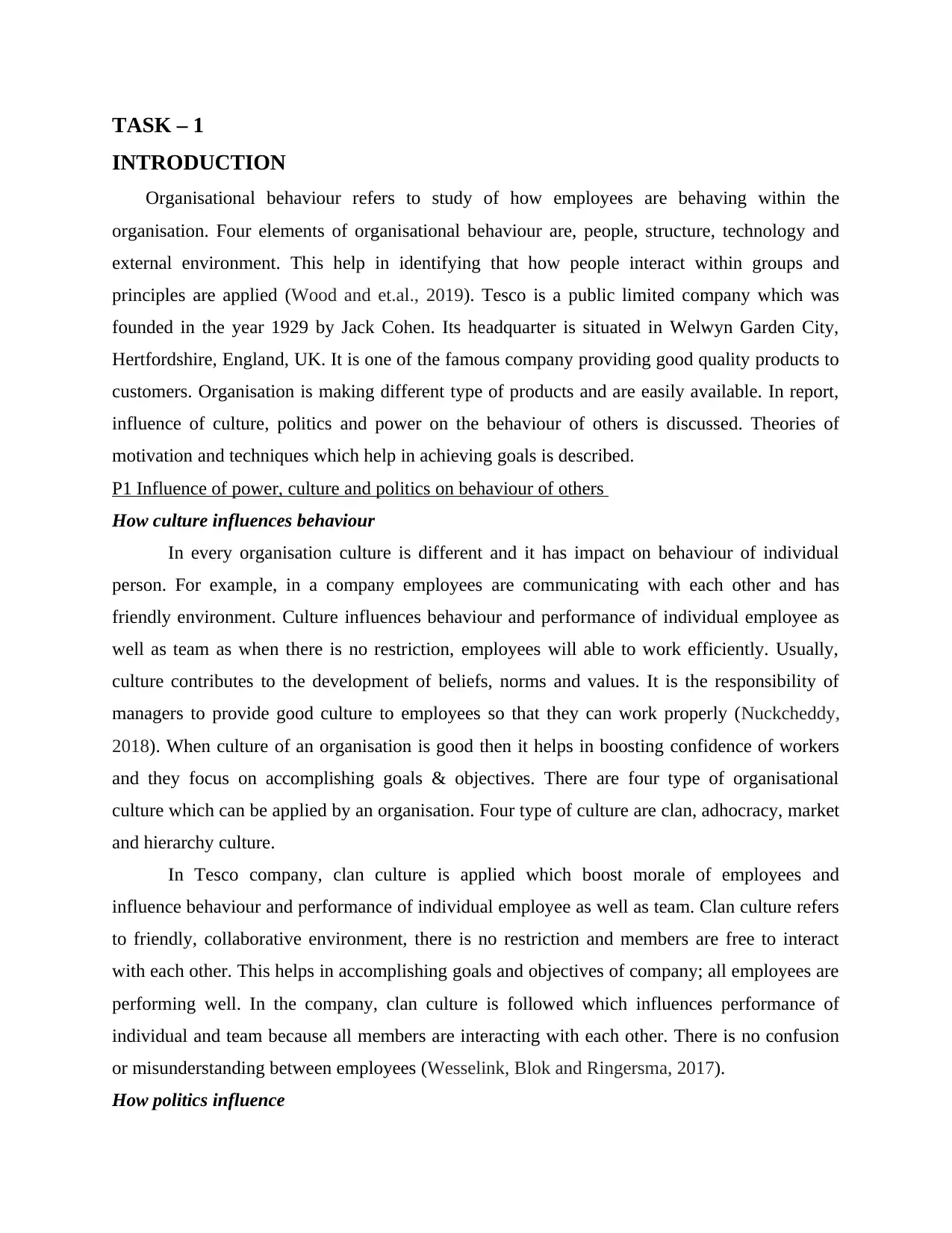
TASK – 1
INTRODUCTION
Organisational behaviour refers to study of how employees are behaving within the
organisation. Four elements of organisational behaviour are, people, structure, technology and
external environment. This help in identifying that how people interact within groups and
principles are applied (Wood and et.al., 2019). Tesco is a public limited company which was
founded in the year 1929 by Jack Cohen. Its headquarter is situated in Welwyn Garden City,
Hertfordshire, England, UK. It is one of the famous company providing good quality products to
customers. Organisation is making different type of products and are easily available. In report,
influence of culture, politics and power on the behaviour of others is discussed. Theories of
motivation and techniques which help in achieving goals is described.
P1 Influence of power, culture and politics on behaviour of others
How culture influences behaviour
In every organisation culture is different and it has impact on behaviour of individual
person. For example, in a company employees are communicating with each other and has
friendly environment. Culture influences behaviour and performance of individual employee as
well as team as when there is no restriction, employees will able to work efficiently. Usually,
culture contributes to the development of beliefs, norms and values. It is the responsibility of
managers to provide good culture to employees so that they can work properly (Nuckcheddy,
2018). When culture of an organisation is good then it helps in boosting confidence of workers
and they focus on accomplishing goals & objectives. There are four type of organisational
culture which can be applied by an organisation. Four type of culture are clan, adhocracy, market
and hierarchy culture.
In Tesco company, clan culture is applied which boost morale of employees and
influence behaviour and performance of individual employee as well as team. Clan culture refers
to friendly, collaborative environment, there is no restriction and members are free to interact
with each other. This helps in accomplishing goals and objectives of company; all employees are
performing well. In the company, clan culture is followed which influences performance of
individual and team because all members are interacting with each other. There is no confusion
or misunderstanding between employees (Wesselink, Blok and Ringersma, 2017).
How politics influence
INTRODUCTION
Organisational behaviour refers to study of how employees are behaving within the
organisation. Four elements of organisational behaviour are, people, structure, technology and
external environment. This help in identifying that how people interact within groups and
principles are applied (Wood and et.al., 2019). Tesco is a public limited company which was
founded in the year 1929 by Jack Cohen. Its headquarter is situated in Welwyn Garden City,
Hertfordshire, England, UK. It is one of the famous company providing good quality products to
customers. Organisation is making different type of products and are easily available. In report,
influence of culture, politics and power on the behaviour of others is discussed. Theories of
motivation and techniques which help in achieving goals is described.
P1 Influence of power, culture and politics on behaviour of others
How culture influences behaviour
In every organisation culture is different and it has impact on behaviour of individual
person. For example, in a company employees are communicating with each other and has
friendly environment. Culture influences behaviour and performance of individual employee as
well as team as when there is no restriction, employees will able to work efficiently. Usually,
culture contributes to the development of beliefs, norms and values. It is the responsibility of
managers to provide good culture to employees so that they can work properly (Nuckcheddy,
2018). When culture of an organisation is good then it helps in boosting confidence of workers
and they focus on accomplishing goals & objectives. There are four type of organisational
culture which can be applied by an organisation. Four type of culture are clan, adhocracy, market
and hierarchy culture.
In Tesco company, clan culture is applied which boost morale of employees and
influence behaviour and performance of individual employee as well as team. Clan culture refers
to friendly, collaborative environment, there is no restriction and members are free to interact
with each other. This helps in accomplishing goals and objectives of company; all employees are
performing well. In the company, clan culture is followed which influences performance of
individual and team because all members are interacting with each other. There is no confusion
or misunderstanding between employees (Wesselink, Blok and Ringersma, 2017).
How politics influence
Paraphrase This Document
Need a fresh take? Get an instant paraphrase of this document with our AI Paraphraser
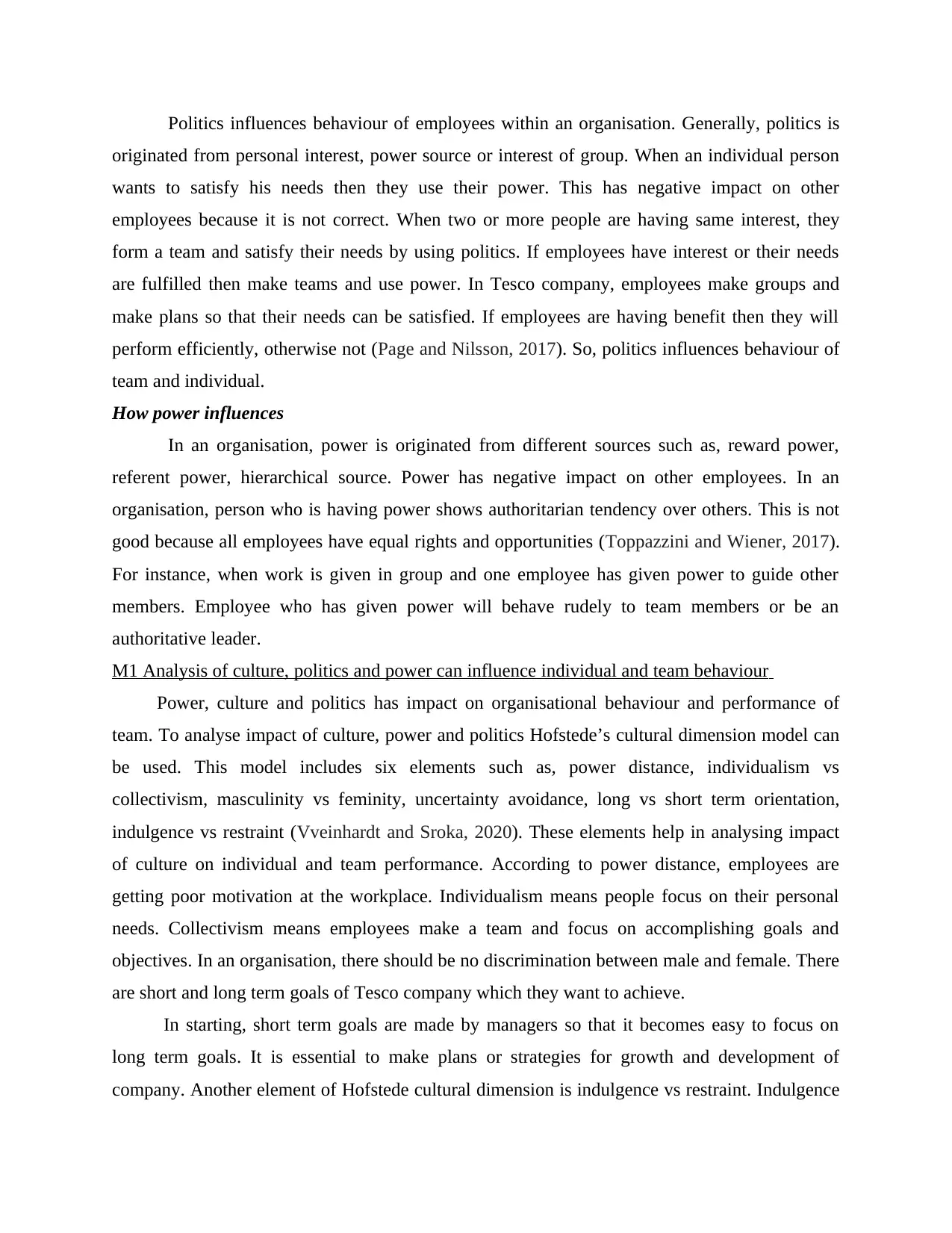
Politics influences behaviour of employees within an organisation. Generally, politics is
originated from personal interest, power source or interest of group. When an individual person
wants to satisfy his needs then they use their power. This has negative impact on other
employees because it is not correct. When two or more people are having same interest, they
form a team and satisfy their needs by using politics. If employees have interest or their needs
are fulfilled then make teams and use power. In Tesco company, employees make groups and
make plans so that their needs can be satisfied. If employees are having benefit then they will
perform efficiently, otherwise not (Page and Nilsson, 2017). So, politics influences behaviour of
team and individual.
How power influences
In an organisation, power is originated from different sources such as, reward power,
referent power, hierarchical source. Power has negative impact on other employees. In an
organisation, person who is having power shows authoritarian tendency over others. This is not
good because all employees have equal rights and opportunities (Toppazzini and Wiener, 2017).
For instance, when work is given in group and one employee has given power to guide other
members. Employee who has given power will behave rudely to team members or be an
authoritative leader.
M1 Analysis of culture, politics and power can influence individual and team behaviour
Power, culture and politics has impact on organisational behaviour and performance of
team. To analyse impact of culture, power and politics Hofstede’s cultural dimension model can
be used. This model includes six elements such as, power distance, individualism vs
collectivism, masculinity vs feminity, uncertainty avoidance, long vs short term orientation,
indulgence vs restraint (Vveinhardt and Sroka, 2020). These elements help in analysing impact
of culture on individual and team performance. According to power distance, employees are
getting poor motivation at the workplace. Individualism means people focus on their personal
needs. Collectivism means employees make a team and focus on accomplishing goals and
objectives. In an organisation, there should be no discrimination between male and female. There
are short and long term goals of Tesco company which they want to achieve.
In starting, short term goals are made by managers so that it becomes easy to focus on
long term goals. It is essential to make plans or strategies for growth and development of
company. Another element of Hofstede cultural dimension is indulgence vs restraint. Indulgence
originated from personal interest, power source or interest of group. When an individual person
wants to satisfy his needs then they use their power. This has negative impact on other
employees because it is not correct. When two or more people are having same interest, they
form a team and satisfy their needs by using politics. If employees have interest or their needs
are fulfilled then make teams and use power. In Tesco company, employees make groups and
make plans so that their needs can be satisfied. If employees are having benefit then they will
perform efficiently, otherwise not (Page and Nilsson, 2017). So, politics influences behaviour of
team and individual.
How power influences
In an organisation, power is originated from different sources such as, reward power,
referent power, hierarchical source. Power has negative impact on other employees. In an
organisation, person who is having power shows authoritarian tendency over others. This is not
good because all employees have equal rights and opportunities (Toppazzini and Wiener, 2017).
For instance, when work is given in group and one employee has given power to guide other
members. Employee who has given power will behave rudely to team members or be an
authoritative leader.
M1 Analysis of culture, politics and power can influence individual and team behaviour
Power, culture and politics has impact on organisational behaviour and performance of
team. To analyse impact of culture, power and politics Hofstede’s cultural dimension model can
be used. This model includes six elements such as, power distance, individualism vs
collectivism, masculinity vs feminity, uncertainty avoidance, long vs short term orientation,
indulgence vs restraint (Vveinhardt and Sroka, 2020). These elements help in analysing impact
of culture on individual and team performance. According to power distance, employees are
getting poor motivation at the workplace. Individualism means people focus on their personal
needs. Collectivism means employees make a team and focus on accomplishing goals and
objectives. In an organisation, there should be no discrimination between male and female. There
are short and long term goals of Tesco company which they want to achieve.
In starting, short term goals are made by managers so that it becomes easy to focus on
long term goals. It is essential to make plans or strategies for growth and development of
company. Another element of Hofstede cultural dimension is indulgence vs restraint. Indulgence
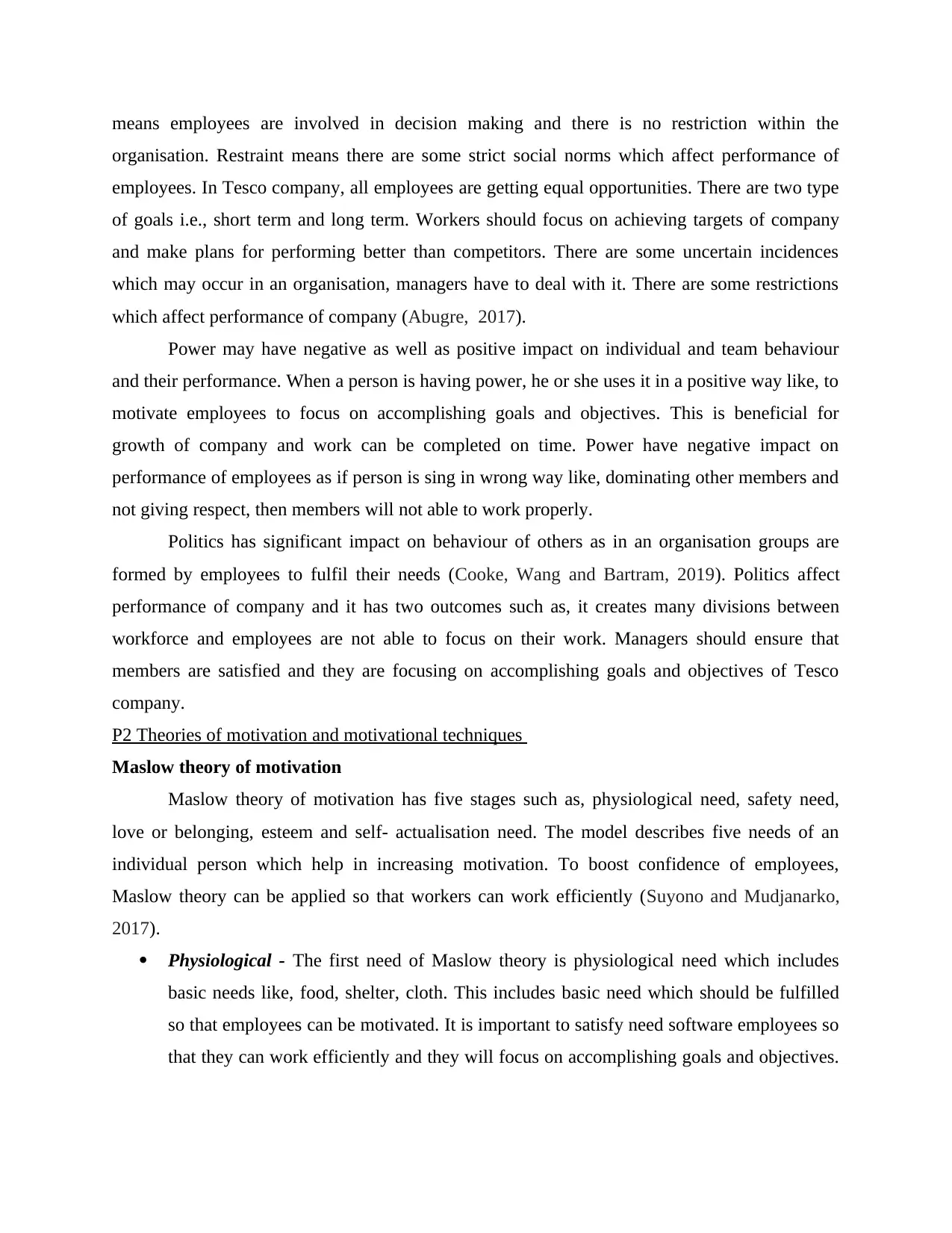
means employees are involved in decision making and there is no restriction within the
organisation. Restraint means there are some strict social norms which affect performance of
employees. In Tesco company, all employees are getting equal opportunities. There are two type
of goals i.e., short term and long term. Workers should focus on achieving targets of company
and make plans for performing better than competitors. There are some uncertain incidences
which may occur in an organisation, managers have to deal with it. There are some restrictions
which affect performance of company (Abugre, 2017).
Power may have negative as well as positive impact on individual and team behaviour
and their performance. When a person is having power, he or she uses it in a positive way like, to
motivate employees to focus on accomplishing goals and objectives. This is beneficial for
growth of company and work can be completed on time. Power have negative impact on
performance of employees as if person is sing in wrong way like, dominating other members and
not giving respect, then members will not able to work properly.
Politics has significant impact on behaviour of others as in an organisation groups are
formed by employees to fulfil their needs (Cooke, Wang and Bartram, 2019). Politics affect
performance of company and it has two outcomes such as, it creates many divisions between
workforce and employees are not able to focus on their work. Managers should ensure that
members are satisfied and they are focusing on accomplishing goals and objectives of Tesco
company.
P2 Theories of motivation and motivational techniques
Maslow theory of motivation
Maslow theory of motivation has five stages such as, physiological need, safety need,
love or belonging, esteem and self- actualisation need. The model describes five needs of an
individual person which help in increasing motivation. To boost confidence of employees,
Maslow theory can be applied so that workers can work efficiently (Suyono and Mudjanarko,
2017).
Physiological - The first need of Maslow theory is physiological need which includes
basic needs like, food, shelter, cloth. This includes basic need which should be fulfilled
so that employees can be motivated. It is important to satisfy need software employees so
that they can work efficiently and they will focus on accomplishing goals and objectives.
organisation. Restraint means there are some strict social norms which affect performance of
employees. In Tesco company, all employees are getting equal opportunities. There are two type
of goals i.e., short term and long term. Workers should focus on achieving targets of company
and make plans for performing better than competitors. There are some uncertain incidences
which may occur in an organisation, managers have to deal with it. There are some restrictions
which affect performance of company (Abugre, 2017).
Power may have negative as well as positive impact on individual and team behaviour
and their performance. When a person is having power, he or she uses it in a positive way like, to
motivate employees to focus on accomplishing goals and objectives. This is beneficial for
growth of company and work can be completed on time. Power have negative impact on
performance of employees as if person is sing in wrong way like, dominating other members and
not giving respect, then members will not able to work properly.
Politics has significant impact on behaviour of others as in an organisation groups are
formed by employees to fulfil their needs (Cooke, Wang and Bartram, 2019). Politics affect
performance of company and it has two outcomes such as, it creates many divisions between
workforce and employees are not able to focus on their work. Managers should ensure that
members are satisfied and they are focusing on accomplishing goals and objectives of Tesco
company.
P2 Theories of motivation and motivational techniques
Maslow theory of motivation
Maslow theory of motivation has five stages such as, physiological need, safety need,
love or belonging, esteem and self- actualisation need. The model describes five needs of an
individual person which help in increasing motivation. To boost confidence of employees,
Maslow theory can be applied so that workers can work efficiently (Suyono and Mudjanarko,
2017).
Physiological - The first need of Maslow theory is physiological need which includes
basic needs like, food, shelter, cloth. This includes basic need which should be fulfilled
so that employees can be motivated. It is important to satisfy need software employees so
that they can work efficiently and they will focus on accomplishing goals and objectives.
⊘ This is a preview!⊘
Do you want full access?
Subscribe today to unlock all pages.

Trusted by 1+ million students worldwide
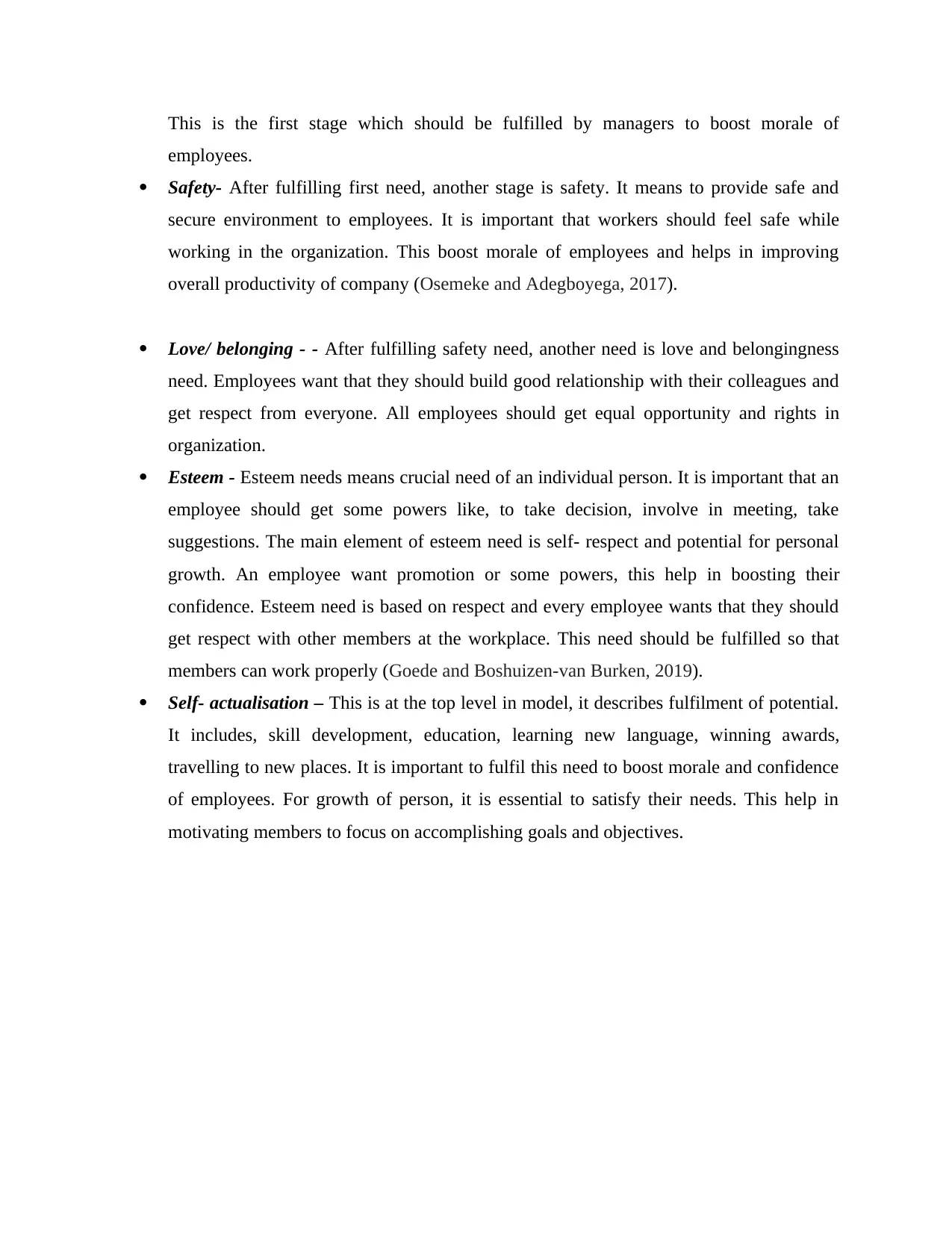
This is the first stage which should be fulfilled by managers to boost morale of
employees.
Safety- After fulfilling first need, another stage is safety. It means to provide safe and
secure environment to employees. It is important that workers should feel safe while
working in the organization. This boost morale of employees and helps in improving
overall productivity of company (Osemeke and Adegboyega, 2017).
Love/ belonging - - After fulfilling safety need, another need is love and belongingness
need. Employees want that they should build good relationship with their colleagues and
get respect from everyone. All employees should get equal opportunity and rights in
organization.
Esteem - Esteem needs means crucial need of an individual person. It is important that an
employee should get some powers like, to take decision, involve in meeting, take
suggestions. The main element of esteem need is self- respect and potential for personal
growth. An employee want promotion or some powers, this help in boosting their
confidence. Esteem need is based on respect and every employee wants that they should
get respect with other members at the workplace. This need should be fulfilled so that
members can work properly (Goede and Boshuizen‐van Burken, 2019).
Self- actualisation – This is at the top level in model, it describes fulfilment of potential.
It includes, skill development, education, learning new language, winning awards,
travelling to new places. It is important to fulfil this need to boost morale and confidence
of employees. For growth of person, it is essential to satisfy their needs. This help in
motivating members to focus on accomplishing goals and objectives.
employees.
Safety- After fulfilling first need, another stage is safety. It means to provide safe and
secure environment to employees. It is important that workers should feel safe while
working in the organization. This boost morale of employees and helps in improving
overall productivity of company (Osemeke and Adegboyega, 2017).
Love/ belonging - - After fulfilling safety need, another need is love and belongingness
need. Employees want that they should build good relationship with their colleagues and
get respect from everyone. All employees should get equal opportunity and rights in
organization.
Esteem - Esteem needs means crucial need of an individual person. It is important that an
employee should get some powers like, to take decision, involve in meeting, take
suggestions. The main element of esteem need is self- respect and potential for personal
growth. An employee want promotion or some powers, this help in boosting their
confidence. Esteem need is based on respect and every employee wants that they should
get respect with other members at the workplace. This need should be fulfilled so that
members can work properly (Goede and Boshuizen‐van Burken, 2019).
Self- actualisation – This is at the top level in model, it describes fulfilment of potential.
It includes, skill development, education, learning new language, winning awards,
travelling to new places. It is important to fulfil this need to boost morale and confidence
of employees. For growth of person, it is essential to satisfy their needs. This help in
motivating members to focus on accomplishing goals and objectives.
Paraphrase This Document
Need a fresh take? Get an instant paraphrase of this document with our AI Paraphraser
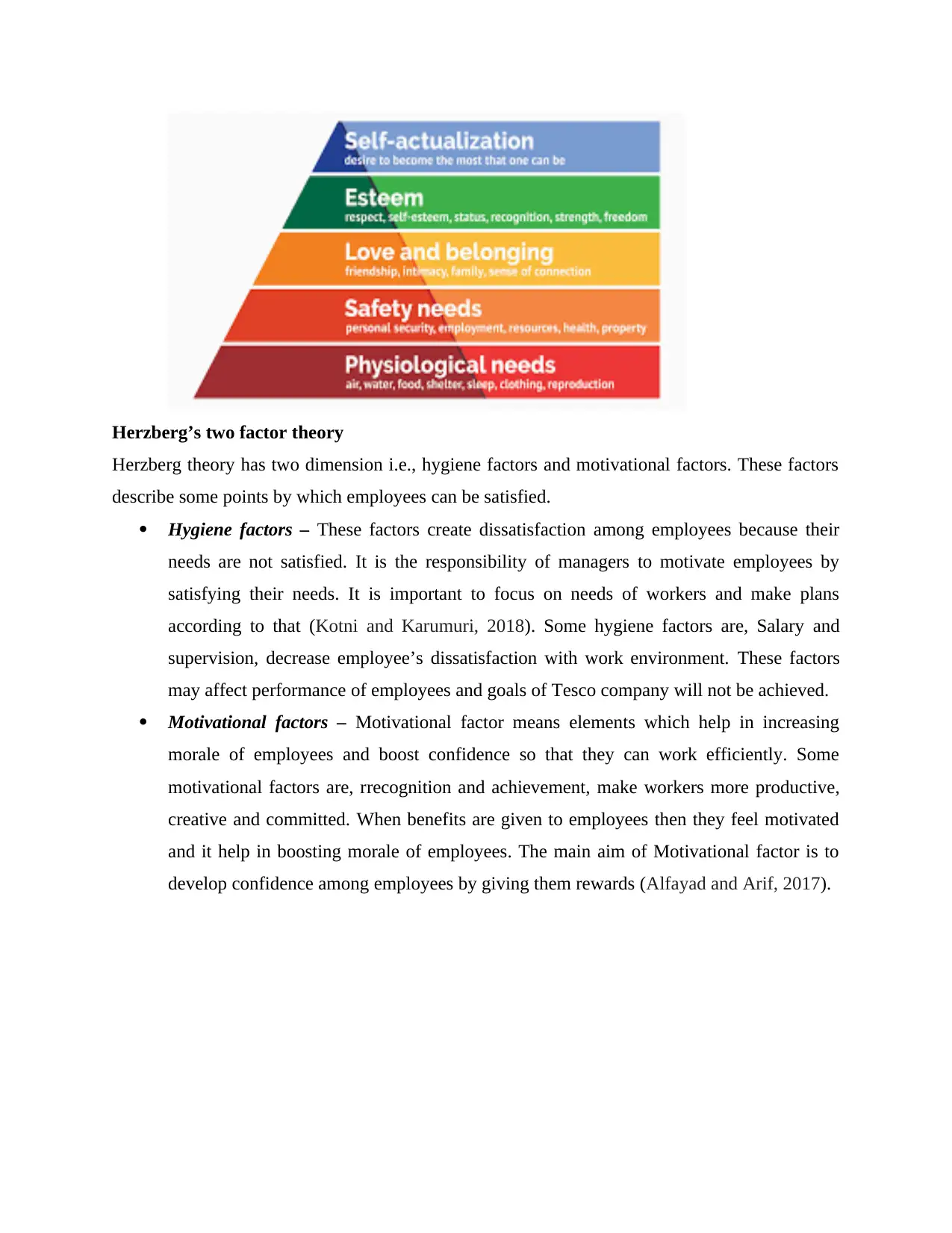
Herzberg’s two factor theory
Herzberg theory has two dimension i.e., hygiene factors and motivational factors. These factors
describe some points by which employees can be satisfied.
Hygiene factors – These factors create dissatisfaction among employees because their
needs are not satisfied. It is the responsibility of managers to motivate employees by
satisfying their needs. It is important to focus on needs of workers and make plans
according to that (Kotni and Karumuri, 2018). Some hygiene factors are, Salary and
supervision, decrease employee’s dissatisfaction with work environment. These factors
may affect performance of employees and goals of Tesco company will not be achieved.
Motivational factors – Motivational factor means elements which help in increasing
morale of employees and boost confidence so that they can work efficiently. Some
motivational factors are, rrecognition and achievement, make workers more productive,
creative and committed. When benefits are given to employees then they feel motivated
and it help in boosting morale of employees. The main aim of Motivational factor is to
develop confidence among employees by giving them rewards (Alfayad and Arif, 2017).
Herzberg theory has two dimension i.e., hygiene factors and motivational factors. These factors
describe some points by which employees can be satisfied.
Hygiene factors – These factors create dissatisfaction among employees because their
needs are not satisfied. It is the responsibility of managers to motivate employees by
satisfying their needs. It is important to focus on needs of workers and make plans
according to that (Kotni and Karumuri, 2018). Some hygiene factors are, Salary and
supervision, decrease employee’s dissatisfaction with work environment. These factors
may affect performance of employees and goals of Tesco company will not be achieved.
Motivational factors – Motivational factor means elements which help in increasing
morale of employees and boost confidence so that they can work efficiently. Some
motivational factors are, rrecognition and achievement, make workers more productive,
creative and committed. When benefits are given to employees then they feel motivated
and it help in boosting morale of employees. The main aim of Motivational factor is to
develop confidence among employees by giving them rewards (Alfayad and Arif, 2017).
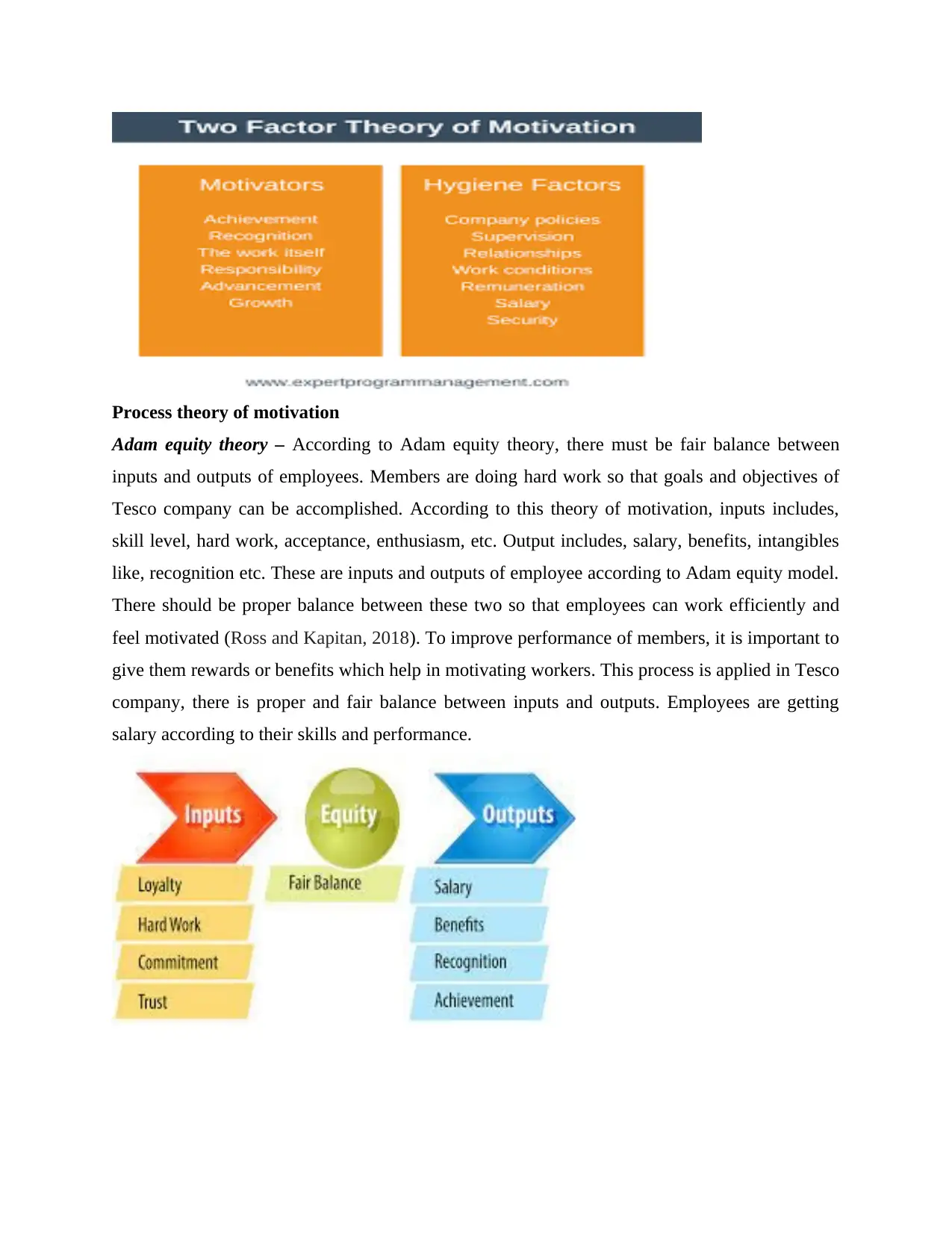
Process theory of motivation
Adam equity theory – According to Adam equity theory, there must be fair balance between
inputs and outputs of employees. Members are doing hard work so that goals and objectives of
Tesco company can be accomplished. According to this theory of motivation, inputs includes,
skill level, hard work, acceptance, enthusiasm, etc. Output includes, salary, benefits, intangibles
like, recognition etc. These are inputs and outputs of employee according to Adam equity model.
There should be proper balance between these two so that employees can work efficiently and
feel motivated (Ross and Kapitan, 2018). To improve performance of members, it is important to
give them rewards or benefits which help in motivating workers. This process is applied in Tesco
company, there is proper and fair balance between inputs and outputs. Employees are getting
salary according to their skills and performance.
Adam equity theory – According to Adam equity theory, there must be fair balance between
inputs and outputs of employees. Members are doing hard work so that goals and objectives of
Tesco company can be accomplished. According to this theory of motivation, inputs includes,
skill level, hard work, acceptance, enthusiasm, etc. Output includes, salary, benefits, intangibles
like, recognition etc. These are inputs and outputs of employee according to Adam equity model.
There should be proper balance between these two so that employees can work efficiently and
feel motivated (Ross and Kapitan, 2018). To improve performance of members, it is important to
give them rewards or benefits which help in motivating workers. This process is applied in Tesco
company, there is proper and fair balance between inputs and outputs. Employees are getting
salary according to their skills and performance.
⊘ This is a preview!⊘
Do you want full access?
Subscribe today to unlock all pages.

Trusted by 1+ million students worldwide
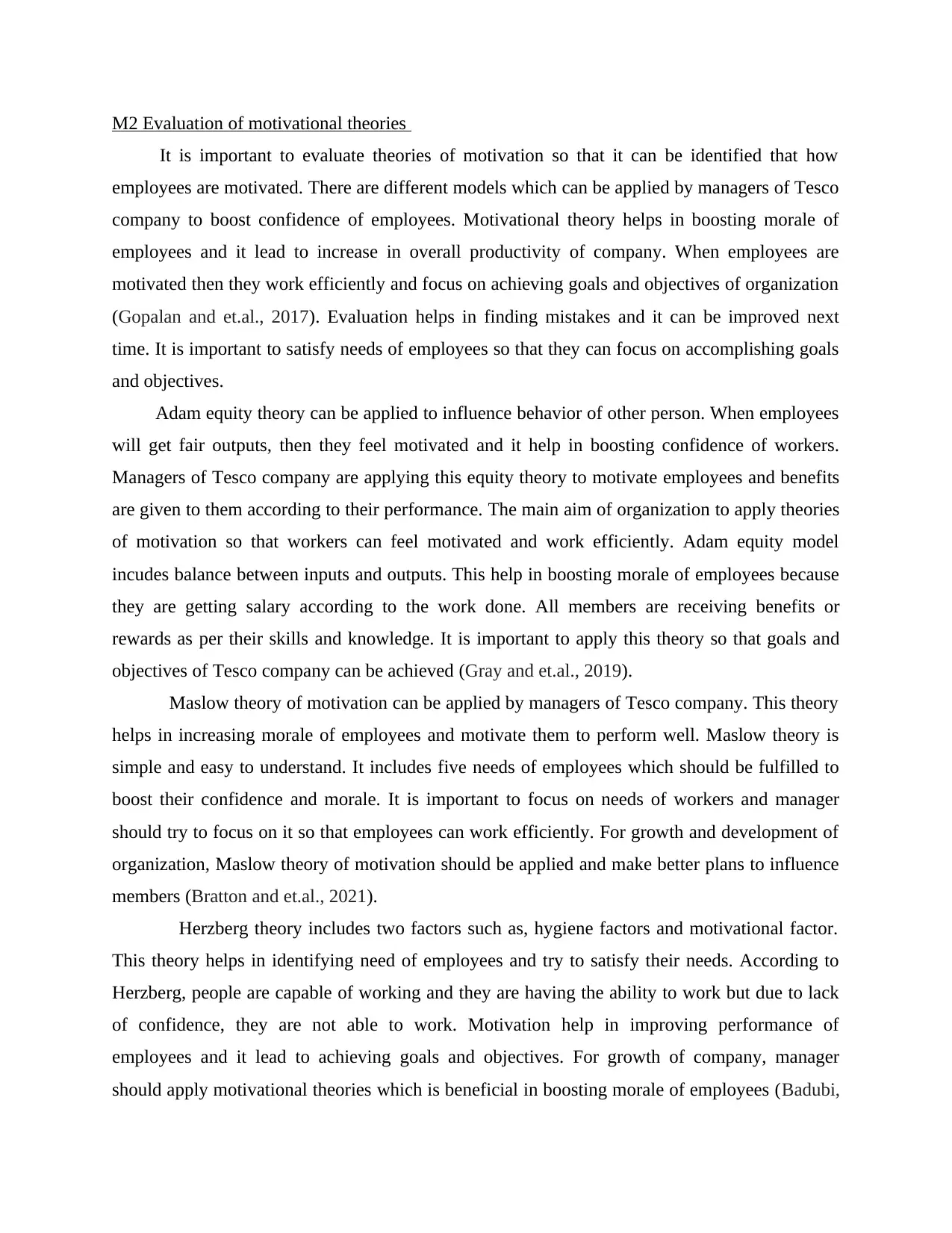
M2 Evaluation of motivational theories
It is important to evaluate theories of motivation so that it can be identified that how
employees are motivated. There are different models which can be applied by managers of Tesco
company to boost confidence of employees. Motivational theory helps in boosting morale of
employees and it lead to increase in overall productivity of company. When employees are
motivated then they work efficiently and focus on achieving goals and objectives of organization
(Gopalan and et.al., 2017). Evaluation helps in finding mistakes and it can be improved next
time. It is important to satisfy needs of employees so that they can focus on accomplishing goals
and objectives.
Adam equity theory can be applied to influence behavior of other person. When employees
will get fair outputs, then they feel motivated and it help in boosting confidence of workers.
Managers of Tesco company are applying this equity theory to motivate employees and benefits
are given to them according to their performance. The main aim of organization to apply theories
of motivation so that workers can feel motivated and work efficiently. Adam equity model
incudes balance between inputs and outputs. This help in boosting morale of employees because
they are getting salary according to the work done. All members are receiving benefits or
rewards as per their skills and knowledge. It is important to apply this theory so that goals and
objectives of Tesco company can be achieved (Gray and et.al., 2019).
Maslow theory of motivation can be applied by managers of Tesco company. This theory
helps in increasing morale of employees and motivate them to perform well. Maslow theory is
simple and easy to understand. It includes five needs of employees which should be fulfilled to
boost their confidence and morale. It is important to focus on needs of workers and manager
should try to focus on it so that employees can work efficiently. For growth and development of
organization, Maslow theory of motivation should be applied and make better plans to influence
members (Bratton and et.al., 2021).
Herzberg theory includes two factors such as, hygiene factors and motivational factor.
This theory helps in identifying need of employees and try to satisfy their needs. According to
Herzberg, people are capable of working and they are having the ability to work but due to lack
of confidence, they are not able to work. Motivation help in improving performance of
employees and it lead to achieving goals and objectives. For growth of company, manager
should apply motivational theories which is beneficial in boosting morale of employees (Badubi,
It is important to evaluate theories of motivation so that it can be identified that how
employees are motivated. There are different models which can be applied by managers of Tesco
company to boost confidence of employees. Motivational theory helps in boosting morale of
employees and it lead to increase in overall productivity of company. When employees are
motivated then they work efficiently and focus on achieving goals and objectives of organization
(Gopalan and et.al., 2017). Evaluation helps in finding mistakes and it can be improved next
time. It is important to satisfy needs of employees so that they can focus on accomplishing goals
and objectives.
Adam equity theory can be applied to influence behavior of other person. When employees
will get fair outputs, then they feel motivated and it help in boosting confidence of workers.
Managers of Tesco company are applying this equity theory to motivate employees and benefits
are given to them according to their performance. The main aim of organization to apply theories
of motivation so that workers can feel motivated and work efficiently. Adam equity model
incudes balance between inputs and outputs. This help in boosting morale of employees because
they are getting salary according to the work done. All members are receiving benefits or
rewards as per their skills and knowledge. It is important to apply this theory so that goals and
objectives of Tesco company can be achieved (Gray and et.al., 2019).
Maslow theory of motivation can be applied by managers of Tesco company. This theory
helps in increasing morale of employees and motivate them to perform well. Maslow theory is
simple and easy to understand. It includes five needs of employees which should be fulfilled to
boost their confidence and morale. It is important to focus on needs of workers and manager
should try to focus on it so that employees can work efficiently. For growth and development of
organization, Maslow theory of motivation should be applied and make better plans to influence
members (Bratton and et.al., 2021).
Herzberg theory includes two factors such as, hygiene factors and motivational factor.
This theory helps in identifying need of employees and try to satisfy their needs. According to
Herzberg, people are capable of working and they are having the ability to work but due to lack
of confidence, they are not able to work. Motivation help in improving performance of
employees and it lead to achieving goals and objectives. For growth of company, manager
should apply motivational theories which is beneficial in boosting morale of employees (Badubi,
Paraphrase This Document
Need a fresh take? Get an instant paraphrase of this document with our AI Paraphraser
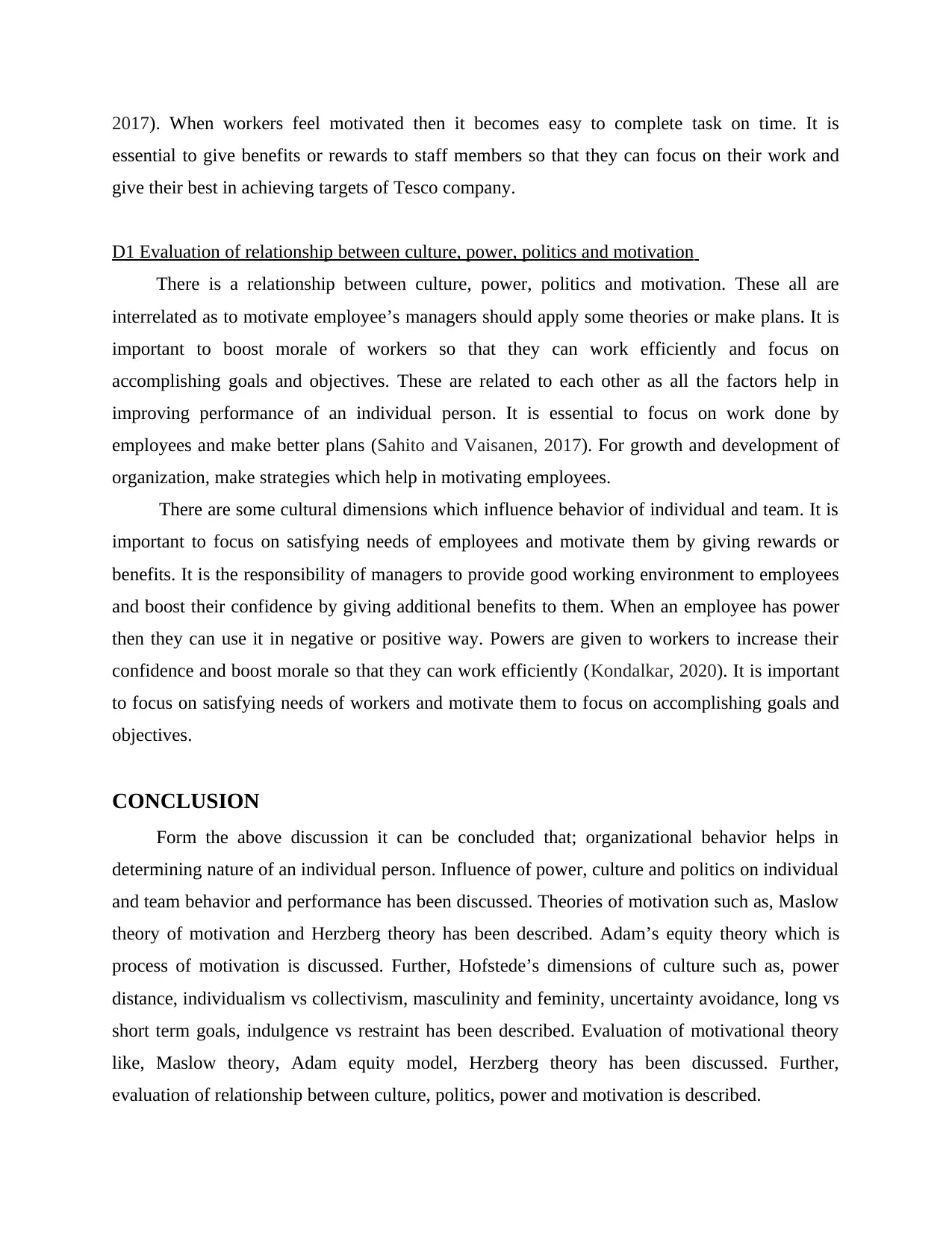
2017). When workers feel motivated then it becomes easy to complete task on time. It is
essential to give benefits or rewards to staff members so that they can focus on their work and
give their best in achieving targets of Tesco company.
D1 Evaluation of relationship between culture, power, politics and motivation
There is a relationship between culture, power, politics and motivation. These all are
interrelated as to motivate employee’s managers should apply some theories or make plans. It is
important to boost morale of workers so that they can work efficiently and focus on
accomplishing goals and objectives. These are related to each other as all the factors help in
improving performance of an individual person. It is essential to focus on work done by
employees and make better plans (Sahito and Vaisanen, 2017). For growth and development of
organization, make strategies which help in motivating employees.
There are some cultural dimensions which influence behavior of individual and team. It is
important to focus on satisfying needs of employees and motivate them by giving rewards or
benefits. It is the responsibility of managers to provide good working environment to employees
and boost their confidence by giving additional benefits to them. When an employee has power
then they can use it in negative or positive way. Powers are given to workers to increase their
confidence and boost morale so that they can work efficiently (Kondalkar, 2020). It is important
to focus on satisfying needs of workers and motivate them to focus on accomplishing goals and
objectives.
CONCLUSION
Form the above discussion it can be concluded that; organizational behavior helps in
determining nature of an individual person. Influence of power, culture and politics on individual
and team behavior and performance has been discussed. Theories of motivation such as, Maslow
theory of motivation and Herzberg theory has been described. Adam’s equity theory which is
process of motivation is discussed. Further, Hofstede’s dimensions of culture such as, power
distance, individualism vs collectivism, masculinity and feminity, uncertainty avoidance, long vs
short term goals, indulgence vs restraint has been described. Evaluation of motivational theory
like, Maslow theory, Adam equity model, Herzberg theory has been discussed. Further,
evaluation of relationship between culture, politics, power and motivation is described.
essential to give benefits or rewards to staff members so that they can focus on their work and
give their best in achieving targets of Tesco company.
D1 Evaluation of relationship between culture, power, politics and motivation
There is a relationship between culture, power, politics and motivation. These all are
interrelated as to motivate employee’s managers should apply some theories or make plans. It is
important to boost morale of workers so that they can work efficiently and focus on
accomplishing goals and objectives. These are related to each other as all the factors help in
improving performance of an individual person. It is essential to focus on work done by
employees and make better plans (Sahito and Vaisanen, 2017). For growth and development of
organization, make strategies which help in motivating employees.
There are some cultural dimensions which influence behavior of individual and team. It is
important to focus on satisfying needs of employees and motivate them by giving rewards or
benefits. It is the responsibility of managers to provide good working environment to employees
and boost their confidence by giving additional benefits to them. When an employee has power
then they can use it in negative or positive way. Powers are given to workers to increase their
confidence and boost morale so that they can work efficiently (Kondalkar, 2020). It is important
to focus on satisfying needs of workers and motivate them to focus on accomplishing goals and
objectives.
CONCLUSION
Form the above discussion it can be concluded that; organizational behavior helps in
determining nature of an individual person. Influence of power, culture and politics on individual
and team behavior and performance has been discussed. Theories of motivation such as, Maslow
theory of motivation and Herzberg theory has been described. Adam’s equity theory which is
process of motivation is discussed. Further, Hofstede’s dimensions of culture such as, power
distance, individualism vs collectivism, masculinity and feminity, uncertainty avoidance, long vs
short term goals, indulgence vs restraint has been described. Evaluation of motivational theory
like, Maslow theory, Adam equity model, Herzberg theory has been discussed. Further,
evaluation of relationship between culture, politics, power and motivation is described.
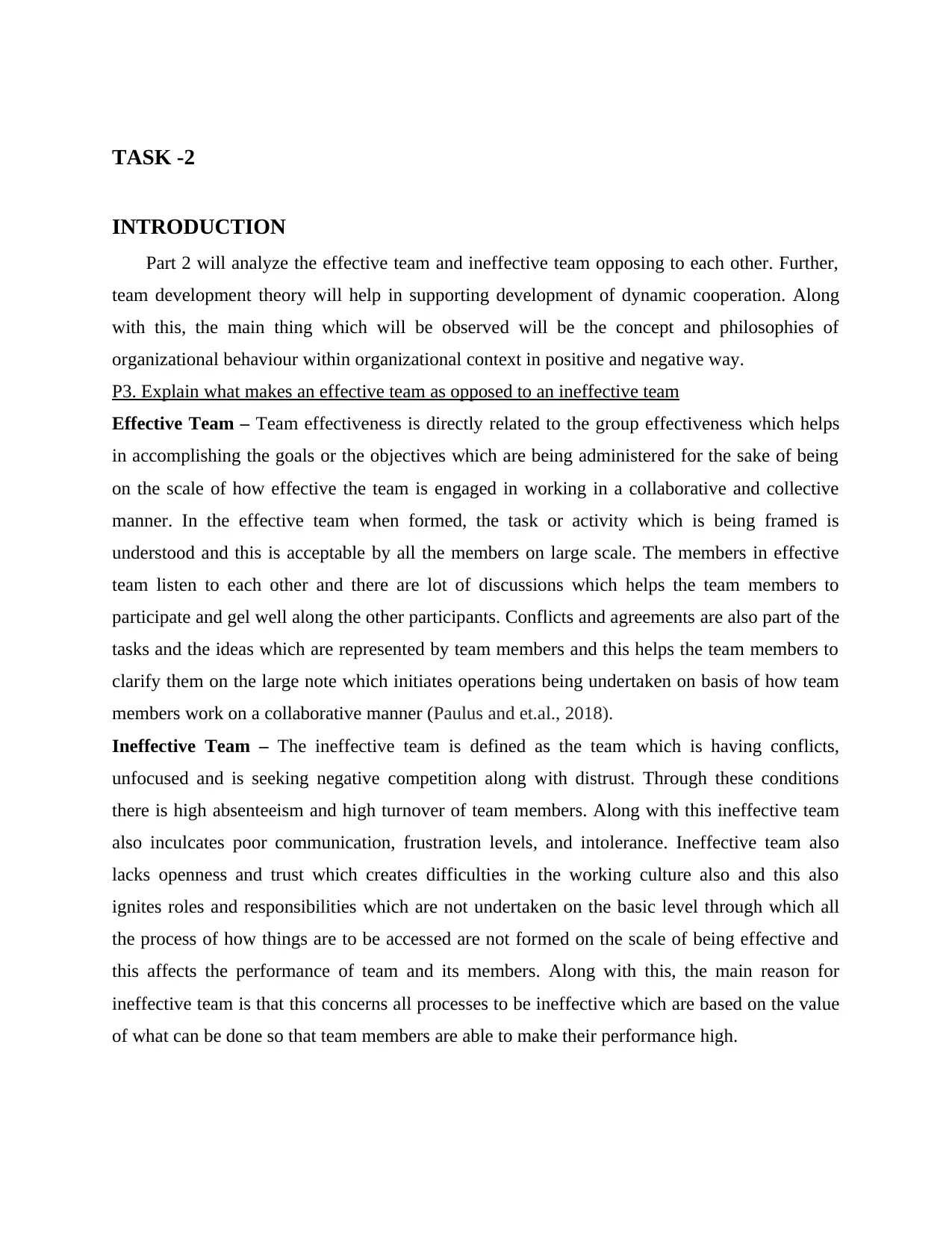
TASK -2
INTRODUCTION
Part 2 will analyze the effective team and ineffective team opposing to each other. Further,
team development theory will help in supporting development of dynamic cooperation. Along
with this, the main thing which will be observed will be the concept and philosophies of
organizational behaviour within organizational context in positive and negative way.
P3. Explain what makes an effective team as opposed to an ineffective team
Effective Team – Team effectiveness is directly related to the group effectiveness which helps
in accomplishing the goals or the objectives which are being administered for the sake of being
on the scale of how effective the team is engaged in working in a collaborative and collective
manner. In the effective team when formed, the task or activity which is being framed is
understood and this is acceptable by all the members on large scale. The members in effective
team listen to each other and there are lot of discussions which helps the team members to
participate and gel well along the other participants. Conflicts and agreements are also part of the
tasks and the ideas which are represented by team members and this helps the team members to
clarify them on the large note which initiates operations being undertaken on basis of how team
members work on a collaborative manner (Paulus and et.al., 2018).
Ineffective Team – The ineffective team is defined as the team which is having conflicts,
unfocused and is seeking negative competition along with distrust. Through these conditions
there is high absenteeism and high turnover of team members. Along with this ineffective team
also inculcates poor communication, frustration levels, and intolerance. Ineffective team also
lacks openness and trust which creates difficulties in the working culture also and this also
ignites roles and responsibilities which are not undertaken on the basic level through which all
the process of how things are to be accessed are not formed on the scale of being effective and
this affects the performance of team and its members. Along with this, the main reason for
ineffective team is that this concerns all processes to be ineffective which are based on the value
of what can be done so that team members are able to make their performance high.
INTRODUCTION
Part 2 will analyze the effective team and ineffective team opposing to each other. Further,
team development theory will help in supporting development of dynamic cooperation. Along
with this, the main thing which will be observed will be the concept and philosophies of
organizational behaviour within organizational context in positive and negative way.
P3. Explain what makes an effective team as opposed to an ineffective team
Effective Team – Team effectiveness is directly related to the group effectiveness which helps
in accomplishing the goals or the objectives which are being administered for the sake of being
on the scale of how effective the team is engaged in working in a collaborative and collective
manner. In the effective team when formed, the task or activity which is being framed is
understood and this is acceptable by all the members on large scale. The members in effective
team listen to each other and there are lot of discussions which helps the team members to
participate and gel well along the other participants. Conflicts and agreements are also part of the
tasks and the ideas which are represented by team members and this helps the team members to
clarify them on the large note which initiates operations being undertaken on basis of how team
members work on a collaborative manner (Paulus and et.al., 2018).
Ineffective Team – The ineffective team is defined as the team which is having conflicts,
unfocused and is seeking negative competition along with distrust. Through these conditions
there is high absenteeism and high turnover of team members. Along with this ineffective team
also inculcates poor communication, frustration levels, and intolerance. Ineffective team also
lacks openness and trust which creates difficulties in the working culture also and this also
ignites roles and responsibilities which are not undertaken on the basic level through which all
the process of how things are to be accessed are not formed on the scale of being effective and
this affects the performance of team and its members. Along with this, the main reason for
ineffective team is that this concerns all processes to be ineffective which are based on the value
of what can be done so that team members are able to make their performance high.
⊘ This is a preview!⊘
Do you want full access?
Subscribe today to unlock all pages.

Trusted by 1+ million students worldwide
1 out of 19
Related Documents
Your All-in-One AI-Powered Toolkit for Academic Success.
+13062052269
info@desklib.com
Available 24*7 on WhatsApp / Email
![[object Object]](/_next/static/media/star-bottom.7253800d.svg)
Unlock your academic potential
Copyright © 2020–2025 A2Z Services. All Rights Reserved. Developed and managed by ZUCOL.




